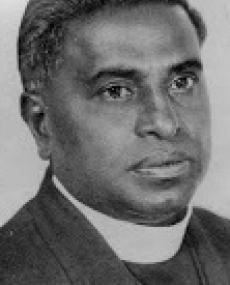
Reverend Bernard Lazarus Emmanuel Sigamoney was a political activist, Christian minister, sportsman and champion of non-racial sport, trade unionist and educator is considered Durban’s most significant socialist and Indian trade unionist.
He is considered one of the few Indian leaders of his day who attempted to transcend racial boundaries with some success and to focus on enhancing the lives of all people. He was not only a man of religion, but was deeply involved in education, sport and politics.
Sigamoney was born in 1888 after his indentured labourer grandparents arrived in South Africa in 1877. His grandfather, Frances Sigamoney was a constable at the magistrate’s court and his father, Emanuel, a waiter. After completing his education Sigamoney became a teacher at Estcourt Indian High School and St Aidan’s Boys’ School, both in Durban. During World War I, Sigamoney became involved in politics and joined the ISL(International Socialist League).
He invited whites to play cricket against Indians in an effort to raise funds for the war effort and to unite whites and Indians. But his attempts were in vain. Sigamoney helped establish, and became the first secretary of, the Indian Workers Industrial Union in 1917. Between 1899 and 1922 Sigamoney was also an active sports administrator in Natal and a prominent boxing promoter in Durban.
Sigamoney took a break from South African politics in December 1922 and travelled abroad to Lincolnshire, England where he studied for four years to be an Anglican pastor. By 1927 he returned to South Africa and moved to Johannesburg. He married and had seven children with his wife Georgina.
He then began to work at St Anthony’s Indian Mission in Vrededorp, Johannesburg as a Christian minister in the Transvaal province. He became concerned with the promotion of Indian sport and the civil rights of people of colour and established sporting clubs and schools for them.
The reverend set up tents in St Anthony’s grounds for tenants who had been evicted from their homes in Pageview. He was revered by the citizens of Pageview and regarded as an advocate for the impoverished.
Sigamoney’s contribution to sport continued throughout his life. In 1940 he formed the South African Indian Cricket Union in Johannesburg. He was a team member and manager of the Transvaal team. In 1946, Sigamoney in partnership with Albert Luthuli founded the Natal Inter-Race Soccer Board which organized competitions among African, Indian and Coloured teams.
In the Transvaal, the trophy is called the Reverend Sigamoney Trophy. Sigamoney also established the Natalspruit Sport Ground and conferred with the Johannesburg City Council for sporting arenas for Indian and Coloured people. In 1958 Sigamoney successfully convinced the African and coloured cricket boards to merge into one non-racial body along with the Indian board.
On 7 October, 1962, SANROC (The South African Non-Racial Olympic Committee) was established. SANROC was concerned with allowing people of all races to represent South Africa in the Olympics.
The body wanted to convince international countries to boycott South African sport and prevent South Africa from participating in international sport as long as racial bans were in place. Sigamoney was a founding official and chairman of SANROC.
Sigamoney passed away on 3 April, 1963.